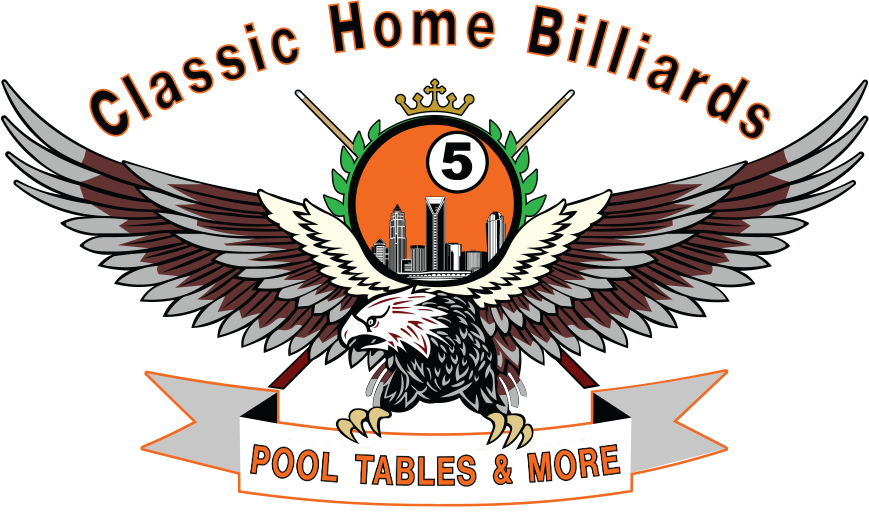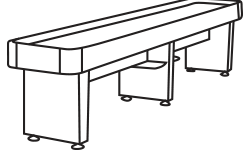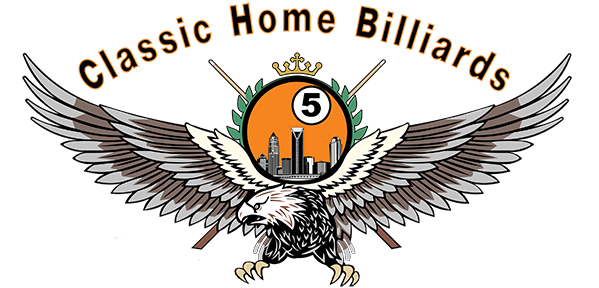Education
WHAT TO LOOK FOR WHEN BUYING A POOL TABLE
Classic Home Billiards Charlotte NC has delt with thousands of first time pool table buyers and their first question is almost always, “What do I need to look for when buying a pool table?” There are many things to consider when purchasing a pool table in today’s billiard industry as there are literally thousands of options. This article is designed to educate you on your purchase and to help protect you from the many scams and diversions that some people fall victim to.
Commercial Styles vs. Furniture Styles
Commercial style tables which are normally found in pool halls, tournaments and professional events are generally designed for serious players and are typically less expensive than quality furniture style tables in the used market due to their lack of cosmetic appeal. Most commercial style tables such as Diamonds and Brunswick Gold Crowns which are the top 2 in this market are designed strictly for play and are normally only found in the homes of serious players and professionals.
Furniture style tables on the other hand are typically designed with the homeowner in mind and follow a more cosmetic design which is the main difference between comercial stye pool tables. Furniture style tables, typically 8′ in length, are normally smaller than commercial style pool tables to accomodate a smaller space, but some furniture models can still be ordered in a professional 9′ size.
Size
These recommendations are based on the play surface of the pool table and 60 in. from the edge of the playing surface to the wall which will accomodate a full length, 57 in. pool cue and 3 in. of stroke if the cue ball is directly against the rail. These are strictly recommendations and can be changed by the length of the cue.
For instance, we recommend a 13′-2″ x 16′-10″ room for your typical Home 8′ pool table (44″ x 88″ play surface). If someone were to have a room that measured 13′-2″ x 16′ they could still make a Home 8′ pool table work fine with a 52″ cue for the occasional tight spot.
A common misconception is that Pro 8′ pool tables are the same size that professionals play on. This is not the case. A Pro 8′ pool table is half way in between a standard home 8′ pool table and full-size 9′ pool table. The play surfaces are as follows:
7 ft. Pool Table Play Surface Area: 38″x76″ (std.) or 39″x78″
8 ft. Pool Table Play Surface Area: 44″x88″
Pro 8 ft. Pool Table Play Surface Area: 46″x92″
9 ft. Pool Table Play Surface Area: 50″x100″
Slate
3-Piece Slate, 1-Piece Slate, or No Slate?
Slate plays a pivotal role in the quality of a pool table. A pool table without a slate playing surface is good for the kids but is not worth more than $100 in any instance. Another very common misconception is that 1-pc. slate pool table are better than 3-pc. slate pool tables because there are no seams. In all reality, it’s exactly the opposite.
A one piece slate pool table consists of a standard frame design and typically four legs. The only adjustment points for leveling are the legs. Depending on the type of leg, the pool table will either have to leveled by placing shims under the legs or with turn feet, which are normally found on the commercial style, coin-operated one piece slate pool tables. Over time, a 1-pc. slate pool table tends to sag in the middle due to all of the weight and there is no way to adjust it thus causing the balls to roll towards the center of the table sometimes to the point where the table is no longer playable and deifinitely not enjoyable by anyone.
Three piece slate pool tables are available in a variety of different styles but a typical 3-pc. consists of three individual pieces which attach to the frame with 4-7 slate screws per piece. Each piece can then be adjusted by driving hardwood wedges between the frame and slate thus allowing the installer to get an accurate level on all points of the table. When a proper assembly is completed the 3 slates will be on the same plane and will be level within .005 in. per sq. ft. using a machinist level. The 3-pc. slate pool table can reach a level accuracy more than 7 times what the 1-pc. slate pool table is capable of. The seams will then be sealed with a torch and bee’s wax to ensure a smooth play surface with no obstructions.
The last thing to consider when it comes to the slate is the style of slate. 3-pc. Framed Slate 3-pc. Unframed Slate 3-pc. Slate Liner
Framed Slate
Framed slate is always the preferred style. The MDF, plywood, or particle board framing will be attached to the slate with glue, screws or both on a framed slate pool table. This allows for the cloth to be stapled on as opposed to gluing (as would have to be done on an unframed slate pool table). The framing also provides ample support for the slate yet still allows for hardwood wedges to be driven between the slate and cabinet/frame of the pool table.
Unframed Slate
Unframed slate, which usually measures 3/4″ thick or lessin some cases in will come in a thicker measurement such as 1″ this is not necessarily a bad design but as the name implies it is not designed with any framing. The frame still acts as the main support for the slate but the felt must then be attached to the slate with an adhesive which has a few downsides. Depending on the installer, if the adhesive is not applied correctly obstructions in the play surface can arise from lumps of glue beneath the felt causing the pool balls to roll off.
Slate Liner
Some tables are designed with a slate liner which is designed with unframed slate and an MDF “framing,” or liner, that is attached to the cabinet/frame instead of the slate itself. This design still allows for the felt to be attached to the slate with staples. The MDF liner will sag over time. This design of table offers the worst playability of the three types of slate as when the liner sags so does the slate causing the seams to slip and extrude from the play surface.
Finish & Wood
Every manufacturer offers a variety of stain, finish and wood options. There are obviously thousands of combinations but you can never go wrong with a solid mahogany or oak design or solid maple. These are not the only recommended woods but they are very popular and are fairly hard woods which prevent gouges and scratches. Keep in mind that dark finishes, such as Traditional Mahogany, show scratches much more easily than the lighter finishes like Oak and Honey. The most durable finish is undoubtedly a formica finish, which is normally found on commercial style pool tables. With modern technology, formica finishes can offer a beautiful wood grain look with the durability of a standard kitchen counter, almost impossible to dent or scratch.
Felt
Most pool tables are offered with standard billiard grade felt, which is by no means “cheap” felt. A common misconception is that standard billiard felt is the same as the felt found in your local fabric store. This is not the case at all. Many have attempted to go buy some fabric and upholster their own table and all have failed. Standard felts will not do the job. They tear too easily and cannot take the abuse that the game of pool will put on them.
Standard, wool-blended billiard grade felts are available in a varity of colors from pink to black and if taken care of properly, they can last up to 10 years or longer. Nylon blend professional grade felts, such as Elite Pro, Simonis, Championship Tour Edition last longer than your standard billiard grade felts they also offer much faster play. These felts are designed with less nap and create much less resistance to the balls than wool blended felts, but are also more expensive but some also offer spill guard which is perfect if you have small ones or even host events.















